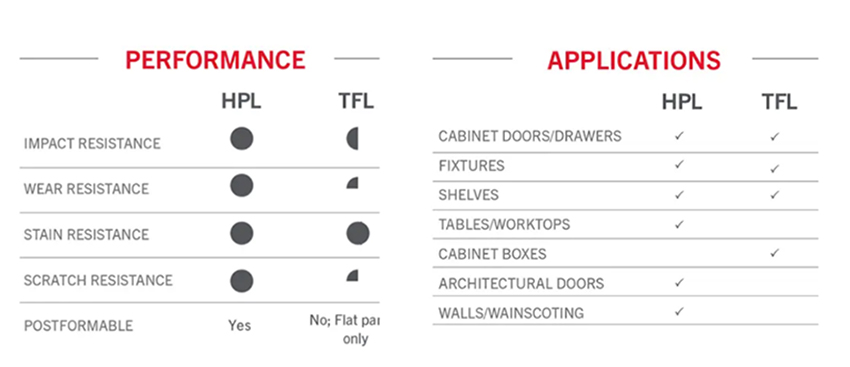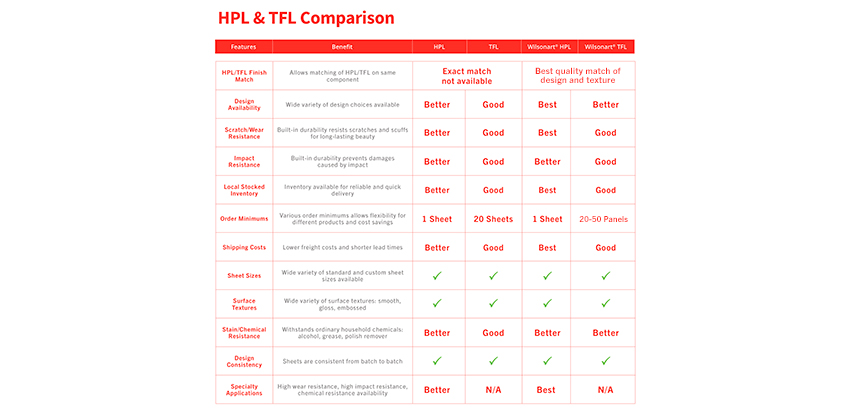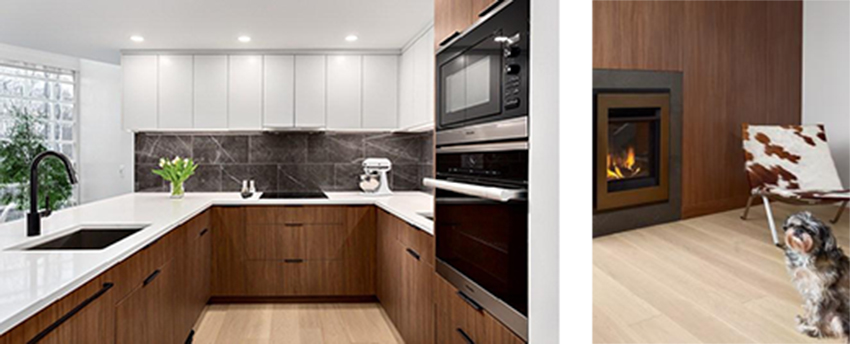Specifying the Right Surface Material
TFL is suitable for appropriate uses in many residential and commercial applications, however, it is different than HPL in several ways. First it is a prebonded panel that is not usually adhered to an additional substrate – it is commonly used for cabinet doors, panels, etc. Second, it does not have the same durability as HPL and is only suitable for many less-demanding uses such as vertical surfaces. TFL can often be combined with HPL in the same spaces with coordinated appearances if the two products are from the same manufacturer. TFL is also inherently stain- and moisture-resistant, making it easy to clean and disinfect.
Since TFL is made available as a manufactured panel, the substrate portion of the panel can be specified to suit particular uses or project needs. Some of the common choices include the following:
- Particleboard is an economical choice that is suitable for furniture, underlayment, TFL wall panels, and HPL countertops.
- Medium-density fiberboard is used for decorative finishes and joinery applications like interior cabinetry and wall and ceiling panels.
- Moisture-resistant fiberboard allows designers to access the benefits of medium-density fiberboard with the added protection of moisture resistance.
- Fire-rated fiberboard is medium-density fiberboard that is specifically manufactured to include flame retardants and prevent flame spread.
- Low VOC products are available as a sustainable substrate for eco-friendly design features with no added formaldehyde.
- FSC-certified substrates are available upon request from some manufacturers.
TFL panels are generally available in 4- and 5-foot widths and in standard lengths of 6, 8, 9, 10, and 12 feet. The edges of the panels can be treated with a separate edgeband material that may be selected to match the surface of the panels or to contrast with it. Many different choices are available and should be confirmed with manufacturers. For added impact resistance along the edge of panels, doors, and surfaces, a thicker edgeband can be specified instead of a more standard thinner one.
Further distinctions about TFL and its most appropriate uses are discussed further as follows:
- Design: TFL surfaces are available in different colors, appearances, and textures including wood grain, although the range of choices are not as broad as for HPL. Since some manufacturers make both materials, TFL can be coordinated with HPL from the same manufacturer for visual coordination in a project or interior space. That allows designers to choose the best material for different applications in a single space or within the same building and still achieve the desired appearance. The panels can be fabricated with standard edge conditions and panel options to complete the overall design look.
- Performance: The decorative layers of TFL provide inherent standard stain and moisture resistance, which also makes it easy to clean and disinfect. However, there is a misconception or misunderstanding that HPL and TFL are equivalent product solutions in terms of performance. In fact, some marketing messages are contributing to the confusion by suggesting or promoting TFL as equal to HPL, but that is not usually accurate. Therefore, it is always best to check manufacturers technical literature and review independent test results for the materials. As noted, the difference in performance makes TFL better suited only for certain applications.
- Sustainability: TFL sustainability is dependent on the substrate material even more so than the surface covering. Depending on the supplier and makeup of the substrate there may or may not be any recycled content or certification. The finished, decorative surfaces may meet some sustainability standards such as UL GREENGUARD Gold Certified for low chemical emissions. Many of the sustainability certifications available for HPL may or may not be available for TFL products, therefore verification of this point is needed by manufacturers who can provide independent testing and certification results.
- Cost-effectiveness: TFL is generally a more affordable product than other surface materials, both in terms of the product and the labor to create a finished panel. However, if it is not used correctly, it will need to be replaced more often than HPL covered surfaces. Note that some designers have found that TFL is being proposed as a “value engineering” alternative to HPL because of lower overall cost. However, since the performance attributes are very different between the two, designers and owners should beware of false economies or false savings if the application does not justify the change.
- Construction Availability: Typically, TFL products aren’t produced ahead of time and warehoused. Rather, they are made for specific projects. Hence, most suppliers will require a minimum-sized order (i.e., 50 – 100 sheets) which may not make it suitable for small projects. The lead time for such an order is often three to four weeks or more but should be verified with local suppliers.


Images courtesy of Wilsonart
Thermo-fused laminate (TFL) has different performance characteristics than HPL, making it better suited to certain applications compared to others.










